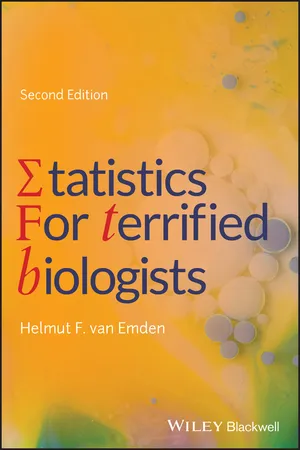
- English
- ePUB (mobile friendly)
- Available on iOS & Android
Statistics for Terrified Biologists
About this book
Makes mathematical and statistical analysis understandable to even the least math-minded biology student
This unique textbook aims to demystify statistical formulae for the average biology student. Written in a lively and engaging style, Statistics for Terrified Biologists, 2nd Edition draws on the author's 30 years of lecturing experience to teach statistical methods to even the most guarded of biology students. It presents basic methods using straightforward, jargon-free language. Students are taught to use simple formulae and how to interpret what is being measured with each test and statistic, while at the same time learning to recognize overall patterns and guiding principles. Complemented by simple examples and useful case studies, this is an ideal statistics resource tool for undergraduate biology and environmental science students who lack confidence in their mathematical abilities.
Statistics for Terrified Biologists presents readers with the basic foundations of parametric statistics, the t-test, analysis of variance, linear regression and chi-square, and guides them to important extensions of these techniques. It introduces them to non-parametric tests, and includes a checklist of non-parametric methods linked to their parametric counterparts. The book also provides many end-of-chapter summaries and additional exercises to help readers understand and practice what they've learned.
- Presented in a clear and easy-to-understand style
- Makes statistics tangible and enjoyable for even the most hesitant student
- Features multiple formulas to facilitate comprehension
- Written by of the foremost entomologists of his generation
This second edition of Statistics for Terrified Biologists is an invaluable guide that will be of great benefit to pre-health and biology undergraduate students.
Frequently asked questions
- Essential is ideal for learners and professionals who enjoy exploring a wide range of subjects. Access the Essential Library with 800,000+ trusted titles and best-sellers across business, personal growth, and the humanities. Includes unlimited reading time and Standard Read Aloud voice.
- Complete: Perfect for advanced learners and researchers needing full, unrestricted access. Unlock 1.4M+ books across hundreds of subjects, including academic and specialized titles. The Complete Plan also includes advanced features like Premium Read Aloud and Research Assistant.
Please note we cannot support devices running on iOS 13 and Android 7 or earlier. Learn more about using the app.
Information
1
How to use this book
Chapter features
- Introduction
- The text of the chapters
- What should you do if you run into trouble?
- Elephants
- The numerical examples in the text
- Boxes
- Spare–time activities
- Executive summaries
- Why go to all that bother?
- The bibliography
Introduction
The text of the chapters
What should you do if you run into trouble?
Elephants

The numerical examples in the text
Boxes
Spare‐time activities
Executive summaries
Table of contents
- Cover
- Table of Contents
- Preface to the second edition
- Preface to the first edition
- 1 How to use this book
- 2 Introduction
- 3 Summarising variation
- 4 When are sums of squares NOT sums of squares?
- 5 The normal distribution
- 6 The relevance of the normal distribution to biological data
- 7 Further calculations from the normal distribution
- 8 The t‐test
- 9 One tail or two?
- 10 Analysis of variance (ANOVA): what is it? How does it work?
- 11 Experimental designs for analysis of variance (ANOVA)
- 12 Introduction to factorial experiments
- 13 2‐Factor factorial experiments
- 14 Factorial experiments with more than two factors – leave this out if you wish!
- 15 Factorial experiments with split plots
- 16 The t‐test in the analysis of variance
- 17 Linear regression and correlation
- 18 Analysis of covariance (ANCOVA)
- 19 Chi‐square tests
- 20 Nonparametric methods (what are they?)
- Appendix A: How many replicates?
- Appendix B: Statistical tables
- Appendix C: Solutions to spare‐time activities
- Appendix D: Bibliography
- Index
- End User License Agreement